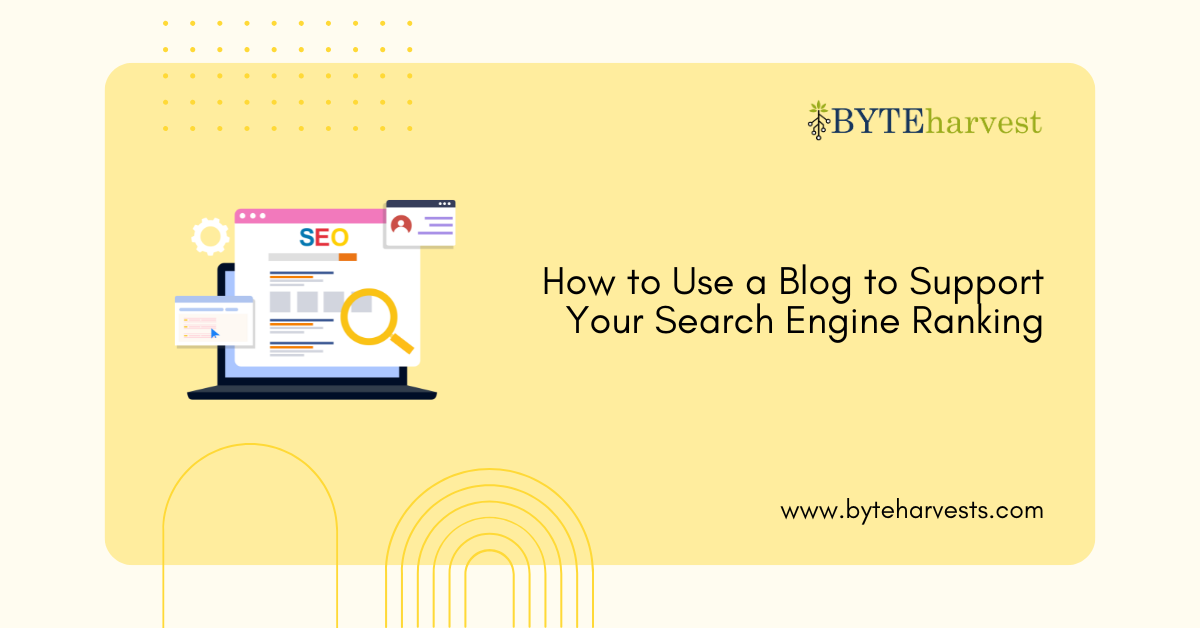How to Use a Blog to Support Your Search Engine Ranking
Optimize Your Blog for Search Engine Ranking: Write Blog Content and Use Proven SEO Strategies to Rank High and Improve Your Search Engine Visibility for Organic Traffic
Want to drive more organic traffic to your blog and rank higher in search engine results? Search engine optimization (SEO) is the key to making your content more discoverable and reaching your target audience through search. In this comprehensive guide, we’ll explore proven tactics to optimize for search engines and improve your position.
A well-optimized blog can significantly increase your online visibility, drive targeted traffic to your site, and ultimately, lead to more conversions and revenue for your business. Whether you’re new to blogging or an experienced content creator, this article will provide valuable insights to help your blog posts rank higher and attract your ideal readers.

Overview of SEO-Friendly Blog Optimization
- Keyword Research: Finding the Right Keywords for SEO and Helping Your Blog Posts Rank Higher
- On-Page SEO Optimization: Optimizing Your Blog Content and Using SEO Best Practices to Rank Higher
- Crafting Compelling Meta Descriptions and Titles for Organic Traffic and Search Engine Optimization
- Image Optimization: The Power of Alt Text and Optimizing Your Images for SEO
- Internal Link Building: Guiding Search Engines, Using a Blog, and Helping Your Blog Posts Rank Higher
- External Link Building: Building Authority, Trust, and Boosting Search Engine Optimization
- Leveraging Social Media for SEO, Blog SEO, and Engagement
- Tracking and Analyzing Your SEO Performance: Blogging Help with SEO
- The Role of Backlinks in Search Engine Ranking and Link Building
- Keeping Up with the Latest SEO Best Practices: Telling Search Engines About Your Optimized Blog Content
Keyword Research: Finding the Right Keywords for SEO and Helping Your Blog Posts Rank Higher
Keyword research is the foundation of any successful SEO strategy. By identifying relevant, high-volume keywords that your target audience is searching for, you can create content that directly addresses their needs and interests. This not only improves your position but also ensures that your blog attracts the right visitors who are more likely to engage with your content and potentially convert into customers or subscribers.
Understanding Search Intent: Before diving into keyword research, it’s essential to understand the concept of search intent. Search intent refers to the underlying goal or purpose behind a user’s search query. By identifying the search intent behind specific keywords, you can tailor your content to better match user expectations, leading to higher satisfaction and engagement rates.
Keyword Research Tools: There are various tools available to assist with keyword research, such as Google Keyword Planner, SEMrush, Ahrefs, and Moz Keyword Explorer. These tools provide valuable insights into search volume, competition levels, and related keywords, allowing you to make informed decisions about which keywords to target.
On-Page SEO Optimization: Optimizing Your Blog Content and Using SEO Best Practices to Rank Higher
Once you’ve identified your target keywords, it’s time to optimize your posts for search engines. On-page SEO refers to the practices you implement within your website’s content and HTML source code to help search engines understand and rank your pages more effectively.
Using Keywords Strategically: Incorporate your target keywords naturally throughout your blog posts, including in the title, headings, meta tags, and body content. However, be cautious of keyword stuffing, as this can harm your position and provide a poor user experience.
Structuring Your Content: Organize your blog posts with clear headings and subheadings, making use of HTML tags like H1, H2, and H3. This hierarchical structure helps search engines understand the main topics and subtopics covered in your content, improving its relevance and readability.
Writing High-Quality, Engaging Content: While optimizing for search engines is important, never compromise on the quality and value of your content. Search engines prioritize well-written, informative, and engaging content that provides a positive user experience. Thoroughly research your topics, offer unique insights, and ensure your writing is clear, concise, and error-free.
Crafting Compelling Meta Descriptions and Titles for Organic Traffic and Search Engine Optimization
Meta descriptions and titles are crucial for both search engines and users. They act as the “snippets” that appear in search engine results, giving users a glimpse of what your blog post is about and enticing them to click through.
Optimizing Meta Descriptions: Your meta description should be a concise, compelling summary of your blog post’s content, typically between 155-160 characters. Include your target keyword naturally, and craft a compelling description that encourages users to click through to your site.
Crafting Attention-Grabbing Titles: Your blog post’s title is one of the first things users will see in search results, so it needs to be attention-grabbing and accurately represent the content. Use your target keyword, but also incorporate emotional triggers, numbers, or power words to make your title more enticing.
Image Optimization: The Power of Alt Text and Optimizing Your Images for SEO
Visual content plays a significant role in enhancing the user experience and engagement on your blog. However, optimizing images for search engines is often overlooked. By properly optimizing your images, you can improve your blog’s visibility in image search results and provide better context for search engines.
Using Relevant Alt Text: Alt text, or alternative text, is a written description of an image that helps search engines understand its content and context. When writing alt text, be descriptive and include relevant keywords while avoiding keyword stuffing.
Optimizing Image File Names and Sizes: Use descriptive, keyword-rich file names for your images, and ensure they are properly sized and compressed to improve page load times, which can indirectly impact your position.
Internal Link Building: Guiding Search Engines, Using a Blog, and Helping Your Blog Posts Rank Higher
Internal linking is the practice of linking to other relevant pages or blog within your website. This not only helps search engines better understand the structure and hierarchy of your content but also improves the user experience by guiding visitors to related and valuable information.
Creating a Clear Site Structure: Develop a logical site structure that organizes your content into categories and subcategories. This makes it easier for search engines to crawl and index your pages, and for users to navigate your site efficiently.
Using Descriptive Anchor Text: When creating internal links, use descriptive and relevant anchor text that accurately describes the linked content. This provides context for both users and search engines, improving the overall user experience and SEO impact.
External Link Building: Building Authority, Trust, and Boosting Search Engine Optimization
While internal linking is important, don’t neglect the value of external linking. By linking to authoritative, relevant, and trustworthy external sources, you demonstrate to search engines that your content is well-researched and backed by credible sources, which can positively impact your position.
Identifying Relevant and Authoritative Sources: When choosing external sources to link to, prioritize reputable and authoritative websites within your industry or niche. Academic institutions, government sites, and well-established publications are often excellent sources to link to.
Providing Additional Context: When linking to external sources, consider adding brief explanations or context to help readers understand the relevance and value of the linked content. This not only enhances the user experience but also demonstrates your expertise and authority on the subject matter.
Leveraging Social Media for SEO, Blog SEO, and Engagement
Social media platforms can be powerful allies in your SEO efforts. By actively promoting your blog content on social media, you can drive more traffic to your site, increase engagement, and potentially earn valuable backlinks from others sharing your content.
Optimizing for Social Sharing: Ensure your blogs are easily shareable on popular social media platforms by incorporating social sharing buttons or click-to-tweet functionality. Additionally, craft attention-grabbing headlines and meta descriptions that will entice people to share your content.
Building Brand Awareness and Engagement: Consistently sharing your blog content on social media can help build brand awareness, establish your authority in your niche, and foster engagement with your audience. Respond to comments, ask questions, and participate in relevant conversations to further amplify your reach and visibility.
Tracking and Analyzing Your SEO Performance: Blogging Help with SEO
Regularly monitoring and analyzing your SEO performance is crucial for understanding what’s working, identifying areas for improvement, and making data-driven decisions to enhance your strategies.
Using Google Search Console: Google Search Console is a free tool that provides valuable insights into how Google crawls, indexes, and ranks your website. By monitoring your performance in Search Console, you can identify issues, track your search traffic, and understand which keywords and pages are driving the most traffic.
Leveraging Analytics Tools: Tools like Google Analytics can provide in-depth data on your website’s traffic sources, user behavior, and engagement metrics. By analyzing this data, you can gain insights into how users interact with your content, identify pain points, and make informed decisions to improve your SEO and user experience.
The Role of Backlinks in Search Engine Ranking and Link Building
Backlinks, or inbound links from other websites pointing to your blog, are a crucial ranking factor for search engines. High-quality backlinks from authoritative and relevant sources signal to search engines that your content is valuable and trustworthy, potentially boosting your position.
Building High-Quality Backlinks: While there are various tactics for building backlinks, focus on creating exceptional, shareable content that naturally attracts links from other reputable websites. Guest blogging, participating in online communities, and conducting outreach to industry influencers can also help you acquire valuable backlinks.
Monitoring and Disavowing Spammy Backlinks: Not all backlinks are created equal. Low-quality or spammy backlinks can actually harm your position. Regularly monitor your backlink profile using tools like Ahrefs or Moz, and disavow any suspicious or low-quality links through Google Search Console. This sends a signal to Google that you don’t endorse or condone these unnatural links, helping to protect your site’s reputation and position.
Keeping Up with the Latest SEO Best Practices: Telling Search Engines About Your Optimized Blog Content
Search engine algorithms are constantly evolving, and SEO practices are continuously changing to keep up with these updates. Staying informed and adapting your strategies accordingly is crucial for maintaining and improving your position over time.
Following Industry Experts and Resources: Follow reputable SEO experts, blogs, and industry publications to stay up-to-date with the latest trends, algorithm updates, and best practices. Attend webinars, participate in online forums, and continuously educate yourself to ensure your SEO strategies remain effective and aligned with search engine guidelines.
Embracing Change and Adapting Quickly: As search engines refine their algorithms to better serve users, be prepared to adapt your SEO strategies accordingly. Stay agile and open to implementing changes to your content, technical SEO, and overall approach to ensure your blog remains visible and competitive in search results.
In summary, optimizing your post for search engines requires a comprehensive and constantly evolving approach. By implementing the strategies outlined in this guide, you’ll be well on your way to improving your position, driving more targeted traffic to your blog, and achieving your content marketing goals.
Remember:
- Conduct thorough keyword research to identify relevant, high-volume keywords
- Optimize your post with on-page SEO best practices
- Craft compelling meta descriptions and titles to entice clicks
- Leverage the power of alt text and image optimization
- Implement internal and external linking strategies
- Promote your content on social media for increased visibility and engagement
- Track and analyze your SEO performance using tools like Google Search Console and Analytics
- Build high-quality backlinks through exceptional content and outreach
- Stay informed about the latest SEO trends and best practices
- Embrace change and adapt your strategies as search engine algorithms evolve
By following these guidelines and continuously refining your approach, you’ll be well-positioned to achieve better rankings, drive more organic traffic to your blog, and ultimately, grow your online presence and business success.






